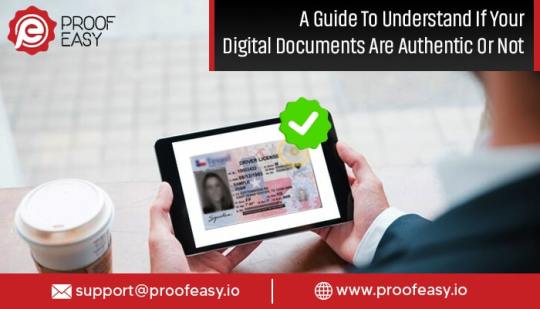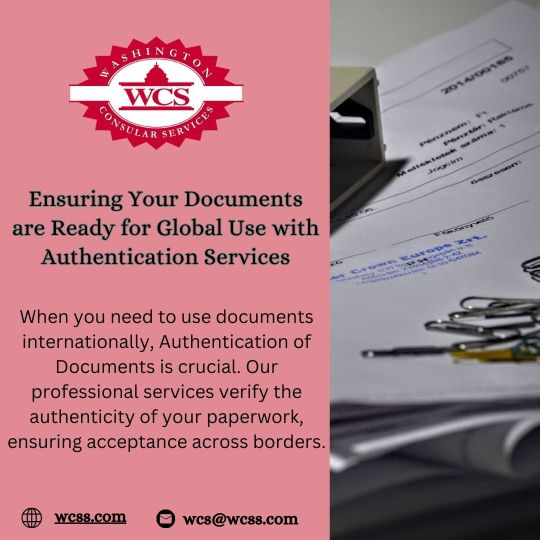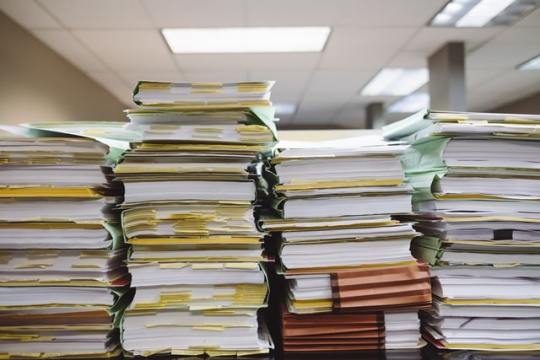#documents authentication
Explore tagged Tumblr posts
Text
How Can You Check Your Digital Document’s Authenticity?

The new normal, rise of remote and hybrid work models, and widespread penetration of the Internet have ushered in the digital era of documents. As more and more businesses and organizations are moving away from paper-based documents or digitizing their existing records, it’s necessary to check if the digital document you have is authentic.
Admittedly, a digital document is eco-friendly, costs less, and doesn’t require copious amounts of real estate to store unlike their paper contemporary, but they are vulnerable to targeted attacks. This means digital documents can be hacked, forged, and altered easily by someone who has the know-how and isn’t afraid to take risks.
In this scenario, it becomes difficult for you to decide if the document you have is original or a tampered version? Worse, what if the presented document digital is fake? Fortunately, there are several methods you can employ to check the authenticity of digital certificates, aka verifiable credentials.
What is a Digital Certificate?
Before we get into the methods you can use, it’s important to understand the meaning of a digital certificate. A digital certificate is similar to a regular digital document. The key difference is this document is hosted on the blockchain. It also follows the guidelines laid down in the Verifiable Credentials Data Model 1.0 by the World Wide Web Consortium (W3C).
Based on its association with blockchain and the data model rules, the document is tamper-proof, can be verified by machines, and uses privacy-enhancing technologies, like decentralized identifiers (DIDs). This is all well and good, but how can a digital certificate prove authenticity?
4 Ways You Can Check the Authenticity of Your Digital Documents
Here are the four ways you can check the authenticity of your digital documents:
1. Verify the Document’s Digital Signature
Digital documents are signed to authorize the information presented and help build trust in the document. Think of them as regular signatures, but more secure and binding. They use popular digital signature protocols like the DSA (digital signature algorithm).
That being said, this type of signature isn’t exempt from fraud. So, how can you verify the document’s digital signature? Look for two key elements in a digital signature to verify its authenticity, including:
Pairing of private and public keys: Since the digital signature certificate is hosted on a blockchain network, it uses public and private keys for signature. Basically, the issuer uses their private key to securely sign a verifiable credential, whereas the public key is shared with the holder or public (in case a lot of people need to access the secured document). Unless the public key matches the private key, no one can decrypt the encrypted message.
Hash code: When the issuer cryptographically signs a document using their private key, a hash code (containing letters and numbers) is generated based on the document’s content. Ultimately, this code is encrypted using the signer’s private key for the development of a digital signature.
These two elements are your guide to verifying the authenticity of your document. The first step is to match the public key with the private key. If a public and private key don’t match, that’s a definite red flag.
The other option is to compare the hash code. A receiver generates a new hash code for the received document when they decode it. This generated hash code should match the hash code generated during signature. If the code isn’t exactly the same, it could be indicative of a tampered and fake document.
2. Check the document’s metadata
A document’s data can often be found in its metadata (the data about data). The metadata will offer details regarding the document’s content, origin, history, and more. The data is your map to explore the hidden paths of the document and learn all about it. You just need to know where to look and be patient while going through the data.
To illustrate, if you want to check the document’s authenticity, you might want to check how it was created and dive deep into the licenses and rights of the document. So, to discover all this information about the document, you’d want to check its administrative metadata. You might also be interested in checking the location of where the document was created. If yes, look for the document’s geospatial metadata.
But if you are more curious about the document’s creator, keywords, its title, and more, you’d get your answers by exploring the descriptive metadata. Similarly, structural metadata will cover details on the document’s structure, like pages, sequence order, chapters, and more.
Simply put, all the data about the document is already there, you just need to exercise patience and go through it with a fine-toothed comb so you don’t leave any interesting crumbs behind.
3. Authenticate the document’s hash value
A document’s hash value is akin to its digital fingerprint. Just like no two fingerprints are the same, no two hash values are the same (though there might be some exceptions). This is mostly because a hash value, a fixed character string of letters and numbers, is generated solely based on the document’s contents.
When secured on the blockchain, the hash code is submitted on the network, too. This makes the hash value immortal. Here’s the kicker: Whenever someone makes a change to the document (think a change as miniscule as a grammar Nazi removing or adding a comma), its hash value changes inexplicably.
This property makes the hash value a game-changer in the world of document security. For instance, when you send a document to a receiver, you just need to provide the original hash value to the receiver. The recipient will then recalculate the document’s hash to ensure it matches the issuer’s. If it doesn’t it’s a clear indicator of a tampered document.
Most blockchain-based document security platforms use the SHA-256 (secure hash algorithm-256) to secure and tamper-proof documents.
4. Examine the document’s digital trail
A digital trail is akin to a document’s history. Think of this exercise as checking a Google Doc’s history. So, basically examining when the document was created and by who. Further, when and how it was edited and who contributed to the edits. This adds another layer of security to the document.
However, this feature isn’t available for all digital documents. This is mostly provided by blockchain security solutions, like ProofEasy, that want to build a digital fortress around all documents and ensure you know exactly what’s happening with your document.
Keeping track of the digital trail will help you stay on track and check if the document has been altered or tampered. It’s important to note that an original document stored on the blockchain can never be altered because whenever you edit it (even if you’re the issuer), a new hash value is created for the document.
So, you’ll always be in the know when a document is altered or tampered with. An absence of a digital trail will also help you identify fake documents and keep your business secure against fraudsters.
Generate Authentic Documents on ProofEasy
ProofEasy is a blockchain and QR code solution that helps secure existing documents and securely issue new documents. The best part, though? You’ll always be in charge of your documents. All you have to do is go to the unified dashboard to keep track of all your documents and manage them.
The cherry on top is the budget-friendly pricing of the solution. But you don’t have to commit to anything until you’re 100% ready. So, why don’t you take ProofEasy for a spin? Simply sign up on the platform to start your free trial. No credit card details are required.
0 notes
Text
Certificate attestation in Canada

Canada's economy is diverse and relies heavily on natural resources, including oil, gas, timber, and minerals. It also has a strong service sector and is known for industries such as technology, aerospace, and finance. So Canada becomes a major centre for migrants who are searching for a better future.
Certificate attestation in Canada refers to the process of verifying the genuineness of a document or certificate issued by a Canadian authority or an authority of another country. Attestation may be required for various purposes, such as immigration, employment, education, etc.
The process of certificate attestation typically involves the following steps:
Notarization: The document must be notarized by a Canadian notary public or a lawyer to verify the identity of the signer and the authenticity of the document.
Authentication: The document must be authenticated by Global Affairs Canada (GAC) to verify that the notary public or lawyer who notarized the document is in good standing and that the seal and signature on the document are genuine.
Legalization: If the document is to be used in a country that is not a member of the Hague Apostille Convention, it must be legalized by the embassy or consulate of that country in Canada. This involves verifying the authenticity of the document and the signature of the GAC official who authenticated it.
The specific requirements for certificate attestation may vary depending on the type of document, the purpose of the attestation, and the country where the document will be used. It is recommended to consult with the relevant authorities or a professional attestation service for guidance on the attestation process.
Helpline group is the trusted name in this field of certificate attestation and company formation. We are providing services in Canada, Middle East countries and India. So we can assist you with the certificate attestation in Canada.
#certificate attestation#birth certificate authentication#apostille#documents authentication#embassy legalization
0 notes
Text
*biting my arm off*
#ra speaks#personal#‘we used to all agreed accounts begging for money was a scam what changed?’#a) circumstances - spam accounts are still active and parasitising the Palestinian cause. these are actively documented tracked and reported#b) platform - spam accounts still prioritize a personal PayPal. very few can bluff past the general protections of platforms like GFM etc.#which while possible is VERY RARE and YOUR DONATIONS ARE PROTECTED IF FRAUD IS FOUND UP TO A YEAR AFTER DONATING#c) random accounts ‘e-begging’ had no process of verification outside of word of mouth#Palestinian fundraisers have several platforms and organizations dedicated to verifying a campaigns authenticity#and d) you either support the concept of mutual aid or you do not. if you don’t fine! don’t reblog mutual aid posts or campaigns or anything#that’s your blog you do you. but don’t scoff at the rest of us willing to take the risk to try helping others#because helping others ALWAYS comes with a risk. why is the white American mutual post trying to pay their utilities bill less of a#potential scam than the Palestinian blogger begging in broken English to feed their children? please explain why the risk of one is#acceptable to you and the other is not. to the class please.#istg people who criticize the campaign process are the most WILLFULLY ignorant people on this site.#literally nothing I can say isn’t covered in detail by more knowledgeable and articulate bloggers#deal with your internalized racism/discomfort from empathy and get over yourself. it’s my money not yours.#do whatever you want forever I’m not a cop#something something the fear of doing something wrong stops a lot of people from doing something right etc etc#sorry if this is snappy my patience is thin. I do so much volunteer work and it’s grating to have people confidently go online and lie.#like why. you can make your own conclusions from the full picture but why make an assertive tumblr post like you’re an authority. you’re not
5 notes
·
View notes
Text
I cannot tell you how many times someone is like "Why is this thing the way it is?" and I say "Because that's how it is" and they're like "Can you show us a document to prove that" and I submit a document that says "Hello. This is the way it is because that's how it is." and they say "Perfect thanks"
#example. nih requires an authentication of biological resources doc IF you have biological resources to authenticate#which we never do. so we dont send that. but then last time they were like we need this addressed#so i submitted a document that said#we are not performing authentication of biological resources because we have no biological resources to authenticate.#and they said#perfect thanks#or like 'why are you requesting tuition in this amount?' 'because that is the amount tuition is' 'perfect thanks'
6 notes
·
View notes
Text
Anticipating the future of malicious open-source packages: next gen insights
New Post has been published on https://thedigitalinsider.com/anticipating-the-future-of-malicious-open-source-packages-next-gen-insights/
Anticipating the future of malicious open-source packages: next gen insights


Ori Abramovsky is the Head of Data Science of the Developer-First group at Check Point, where he leads the development and application of machine learning models to the source code domain. With extensive experience in various machine learning types, Ori specializes in bringing AI applications to life. He is committed to bridging the gap between theory and real-world application and is passionate about harnessing the power of AI to solve complex business challenges.
In this thoughtful and incisive interview, Check Point’s Developer-First Head of Data Science, Ori Abramovsky discusses malicious open-source packages. While malicious open-source packages aren’t new, their popularity among hackers is increasing. Discover attack vectors, how malicious packages conceal their intent, and risk mitigation measures. The best prevention measure is…Read the interview to find out.
What kinds of trends are you seeing in relation to malicious open-source packages?
The main trend we’re seeing relates to the increasing sophistication and prevalence of malicious open-source packages. While registries are implementing stricter measures, such as PyPI’s recent mandate for users to adopt two-factor authentication, the advances of Large Language Models (LLMs) pose significant challenges to safeguarding against such threats. Previously, hackers needed substantial expertise in order to create malicious packages. Now, all they need is access to LLMs and to find the right prompts for them. The barriers to entry have significantly decreased.
While LLMs democratise knowledge, they also make it much easier to distribute malicious techniques. As a result, it’s fair to assume that we should anticipate an increasing volume of sophisticated attacks. Moreover, we’re already in the middle of that shift, seeing these attacks extending beyond traditional domains like NPM and PyPI, manifesting in various forms such as malicious VSCode extensions and compromised Hugging Face models. To sum it up, the accessibility of LLMs empowers malicious actors, indicating a need for heightened vigilance across all open-source domains. Exciting yet challenging times lie ahead, necessitating preparedness.
Are there specific attack types that are most popular among hackers, and if so, what are they?
Malicious open-source packages can be applied based on the stage of infection: install (as part of the install process), first use (once the package has been imported), and runtime (infection is hidden as part of some functionality and will be activated once the user will use that functionality). Install and first use attacks typically employ simpler techniques; prioritizing volume over complexity, aiming to remain undetected long enough to infect users (assuming that some users will mistakenly install them). In contrast, runtime attacks are typically more sophisticated, with hackers investing efforts in concealing their malicious intent. As a result, the attacks are harder to detect, but come with a pricier tag. They last longer and therefore have higher chances of becoming a zero-day affecting more users.
Malicious packages employ diverse methods to conceal their intent, ranging from manipulating package structures (the simpler ones will commonly include only the malicious code, the more sophisticated ones can even be an exact copy of a legit package), to employing various obfuscation techniques (from classic methods such as base64 encoding, to more advanced techniques, such as steganography). The downside of using such concealment methods can make them susceptible to detection, as many Yara detection rules specifically target these signs of obfuscation. Given the emergence of Large Language Models (LLMs), hackers have greater access to advanced techniques for hiding malicious intent and we should expect to see more sophisticated and innovative concealment methods in the future.
Hackers tend to exploit opportunities where hacking is easier or more likely, with studies indicating a preference for targeting dynamic installation flows in registries like PyPI and NPM due to their simplicity in generating attacks. While research suggests a higher prevalence of such attacks in source code languages with dynamic installation flows, the accessibility of LLMs facilitates the adaptation of these attacks to new platforms, potentially leading hackers to explore less visible domains for their malicious activities.
How can organisations mitigate the risk associated with malicious open-source packages? How can CISOs ensure protection/prevention?
The foremost strategy for organisations to mitigate the risk posed by malicious open-source packages is through education. One should not use open-source code without properly knowing its origins. Ignorance in this realm does not lead to bliss. Therefore, implementing practices such as double-checking the authenticity of packages before installation is crucial. Looking into aspects like the accuracy of package descriptions, their reputation, community engagement (such as stars and user feedback), the quality of documentation in the associated GitHub repository, and its track record of reliability is also critical. By paying attention to these details, organisations can significantly reduce the likelihood of falling victim to malicious packages.
The fundamental challenge lies in addressing the ignorance regarding the risks associated with open-source software. Many users fail to recognize the potential threats and consequently, are prone to exploring and installing new packages without adequate scrutiny. Therefore, it is incumbent upon Chief Information Security Officers (CISOs) to actively participate in the decision-making process regarding the selection and usage of open-source packages within their organisations.
Despite best efforts, mistakes can still occur. To bolster defences, organisations should implement complementary protection services designed to monitor and verify the integrity of packages being installed. These measures serve as an additional layer of defence, helping to detect and mitigate potential threats in real-time.
What role does threat intelligence play in identifying and mitigating risks related to open-source packages?
Traditionally, threat intelligence has played a crucial role in identifying and mitigating risks associated with open-source packages. Dark web forums and other underground channels were primary sources for discussing and sharing malicious code snippets. This allowed security professionals to monitor and defend against these snippets using straightforward Yara rules. Additionally, threat intelligence facilitated the identification of suspicious package owners and related GitHub repositories, aiding in the early detection of potential threats. While effective for simpler cases of malicious code, this approach may struggle to keep pace with the evolving sophistication of attacks, particularly in light of advancements like Large Language Models (LLMs).
These days, with the rise of LLMs, it’s reasonable to expect hackers to innovate new methods through which to conduct malicious activity, prioritizing novel techniques over rehashing old samples that are easily identifiable by Yara rules. Consequently, while threat intelligence remains valuable, it should be supplemented with more advanced analysis techniques to thoroughly assess the integrity of open-source packages. This combined approach ensures a comprehensive defence against emerging threats, especially within less-monitored ecosystems, where traditional threat intelligence may be less effective.
What to anticipate in the future?
The emergence of Large Language Models (LLMs) is revolutionising every aspect of the software world, including the malicious domain. From the perspective of hackers, this development’s immediate implication equates to more complicated malicious attacks, more diverse attacks and more attacks, in general (leveraging LLMs to optimise strategies). Looking forward, we should anticipate hackers trying to target the LLMs themselves, using techniques like prompt injection or by trying to attack the LLM agents. New types and domains of malicious attacks are probably about to emerge.
Looking at the malicious open-source packages domain in general, a place we should probably start watching is Github. Historically, malicious campaigns have targeted open-source registries such as PyPI and NPM, with auxiliary support from platforms like GitHub, Dropbox, and Pastebin for hosting malicious components or publishing exploited data pieces. However, as these registries adopt more stringent security measures and become increasingly monitored, hackers are likely to seek out new “dark spots” such as extensions, marketplaces, and GitHub itself. Consequently, malicious code has the potential to infiltrate EVERY open-source component we utilise, necessitating vigilance and proactive measures to safeguard against such threats.
#Accessibility#ai#Analysis#applications#approach#attention#authentication#Business#challenge#Check Point#CISOs#code#Community#complexity#comprehensive#Dark#Dark web#data#data privacy#data protection#data science#details#detection#Developer#development#documentation#domains#double#dropbox#Ecosystems
3 notes
·
View notes
Text
In the decretal commission for Henry’s case, the ‘facts’ under scrutiny were three, all related to the original dispensation granted so that Henry could marry his sister-in-law: Had the marriage between Henry and Katherine been necessary to preserve the peace between England and Spain? Had Henry agreed to the marriage in order to preserve this peace? Had Henry VII, Isabella, or Ferdinand died before the dispensation went into effect? The questions were so posed that not only was it easy to arrive at the factually correct answers, but the answers themselves would be precisely those that would most effectively undermine the validity of the dispensation . . . it was to be laid down in the decretal commission that it required the facts in only one of the three matters to be investigated to prove inconsistent with what was stated in the dispensation for the marriage to be declared invalid.’’ Since the document was destroyed, it is impossible to determine how far Clement went along with this ruse, but given that it was destroyed by papal order one can safely assume that the solution it contained was in the king’s favor.
The Italian Encounter with Tudor England: A Cultural Politics of Translation, Michael Wyatt
#the great matter files#michael wyatt#henrician#henry viii#part of wolsey's downfall was seeded in believing the decretal commission was...#well. not an authentic document. bcus it was .#but a document presented to them in good faith#altho tbh kind of surprised his and henry's antennas didn't go up more at campeggio refusing to provide either of them with a copy....#that would've been a fail-safe propaganda technique#to be able to disseminate throughout england even if campeggio had either declared in catherine's favour or prorogued as he did
2 notes
·
View notes
Text
.
#admittedly a little worried abt the way ur just completely fucked if you lose ur phone now#(with everything for work & important documents & such requiring 2-factor authentication)#this seems like. bad design. before we even get to the ppl who can't afford phones or can't use em for whatever reason#i just. don't think it should be mandatory. i think that's bad actually even tho obviously its good security#bytebun rambles#to delete#when u work w seniors it becomes so clear how much tech is designed by people who frankly never expect to age or whatever#not my problem tho. mostly cuz i can't do shit about it
7 notes
·
View notes
Text
I’m going to kill someone. I ran a scan through my computer and now my Sticky Notes have been deleted. 3-4 years’ worth of notes have completely vanished. The worst one was my transcript word count which showed progress throughout the 18 months Regicide has been going. Like I can rewrite the months and totals but there were bits where a month’s total ended on the 16th because I was checking for a month anniversary which cannot be replicated. It will never be the same.
#holly talks#I've been backing up the transcripts themselves by transferring the completed word documents to google drive#but like the totals didn't feel as important to back up because they were just calculations#I'll remake the note and back it up on drive but the authenticity is gone god fucking damn it#literally why would a virus and decluttering scan decide to destroy all the data in my sticky notes app what the fuck
3 notes
·
View notes
Text
see ideologically i would LOVE to pay my taxes. big fan of public services. love me a library and some public health. unfortunately the tax people have decided to make the most complex network of services and accounts possible because they really really really dont want me to pay my taxes
#like ok i want to do my taxes how do i do that?#u gotta get into this website. to get in u need ur tax returns from the past 6 years#i was a literal child 6 years ago is there any other way?#of course! make an account in another platform first. ok now you have to authenticate twice#uhm okay how do i do that?#either you enter your tax return numbers from the past 6 years (NO!!!!) or you get in through ur bank oh yeah btw u have to download an app#ok ill use my bank then?#great! first you have to unblock your device. well send u an sms to do that.#oh youre abroad? then u have to write out a document by hand scan it and send it along with a pic of your passport#my passport is expired though#well get a new one#I CANT BC I HAVE A LATE FEE ON MY TAXES I HAVE TO PAY TO REGISTER AS A VOTER TO BE ALLOWED TO GET A PASSPORT#well ok then u have to do your taxes first.#IM KMS
3 notes
·
View notes
Text
U.S. Intensifies Crackdown on Undocumented Immigrants, Increasing Demand for Remote Immigration Document Services
As the U.S. government strengthens immigration enforcement, the demand for expedited visa and residency document issuance and authentication services is surging among immigrants. Recently, U.S. authorities have expanded their crackdown to include individuals with expired visas and those lacking proper immigration documentation, leading to an increase in detentions and deportations. These…
#apostille certification#visa authentication#online document processing#document verification#immigration documents
0 notes
Text
When it comes to legal documents, accuracy and convenience are critical. Opting for mobile notary services ensures your notarization needs are met without the hassle of traveling to an office. Here’s why mobile notary services are a valuable choice, particularly for residents and businesses.
0 notes
Text
When it comes to ensuring your decisions are carried out as you wish, ensuring that your Power of Attorney (POA) document is notarized correctly is crucial. Notary services in Santa Rosa, California, are here to make this process as smooth as possible, ensuring that your legal documents are handled with care and accuracy. Notarizing a POA is critical in granting someone the authority to legally act on your behalf.
0 notes
Text
Everything You Should Know About Notarization

Notarization is a crucial process in verifying the authenticity of legal documents and signatures. It serves as a safeguard to ensure that agreements, affidavits, and other documents are legally valid and enforceable. A mobile notary brings this essential service to your doorstep, providing unparalleled convenience. This eliminates the need for you to travel to a notary’s office, which is especially beneficial for busy professionals or individuals with limited mobility.
Read More: https://www.raismobilenotary.com/everything-you-should-know-about-notarization
0 notes
Text

When you need to use documents internationally, Authentication of Documents is crucial. Our professional services verify the authenticity of your paperwork, ensuring acceptance across borders.
0 notes
Text

https://www.usauthentication.com/us-authentication-services/document-authentication.php - In today’s global marketplace, the authenticity of commercial documents is crucial. Whether for international trade, legal contracts, or business transactions, ensuring documents are genuine helps maintain trust and prevents fraud. Proper authentication of commercial documents is a key step in ensuring business integrity and facilitating smooth global operations.
0 notes
Text
Importance of Document Certification in the UK
Being a vital procedure in the UK, the document certification authenticates the original documents to prove their legitimacy. It is a crucial procedure that is required for diverse purposes like legal, financial, and administrative settings to ensure that the documents being presented are genuine and have not been tampered with. It is required when the original cannot be provided, such as for international transactions, visa applications, or applying for a new job.

Who Can Perform the Document Certification?
Document certification is performed by authorised professionals like solicitors, notaries, or other individuals recognised as 'authorised persons.' They verify that the copy is a true and accurate representation of the original by signing, dating, and often stamping the document. One of the most common uses of certified documents is in legal matters, such as proving identity or ownership in court proceedings.
Financial institutions may require certified copies of passports or utility bills for anti-money laundering checks. Similarly, certified documents are frequently needed in property transactions, where they play a crucial role in verifying the identities of buyers and sellers.
Document Certification and Its Importance on Educational Settings
Document certification also plays a key role in educational settings, particularly when applying to universities abroad. Institutions often request certified copies of academic transcripts and certificates to confirm the applicant's qualifications. It is crucial to safeguard and maintain the integrity of important processes, ensuring that all parties involved can trust the documents being presented.
0 notes